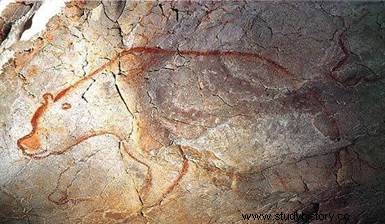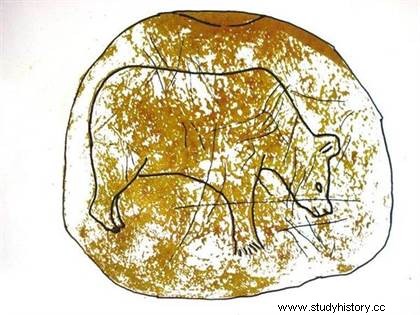 Prehistoric Man rubbed shoulders with the Cave Bears , lived in the same caves , fed on them and collected their furs. They also inspired their art . But many mysteries remain about this relationship between Man and animal:was he chasing this force of Nature? Was he content to cut up carrion? What place did the bear take in the symbolic universe of the first societies? A cult was it dedicated to him?
Prehistoric Man rubbed shoulders with the Cave Bears , lived in the same caves , fed on them and collected their furs. They also inspired their art . But many mysteries remain about this relationship between Man and animal:was he chasing this force of Nature? Was he content to cut up carrion? What place did the bear take in the symbolic universe of the first societies? A cult was it dedicated to him?
The Bears
Appeared 1.8 million years ago, Ursus deningeri is the ancestor of two other species, Ursus spelaeus (cave bear) and Ursus arctos (brown bear) . The cave bear appeared about 250,000 years ago where it lived in Europe, from southern England to the Caucasus, and even as far as the Ural Mountains mainly in mountainous areas with mixed forests. It was rarely found in glacial areas without forests where the climate was cold and dry.
Standing the male could reach 3m50, 1m30 at the withers and weighed 400 to 600 kilos. The morphology of its head is different from that of other species. It consisted of a low forehead, a frontal hump and a less developed muzzle. The stocky, massive body with an overall sloping profile at the hindquarters as their front legs are longer and sturdier than the hind legs. Their neck is quite long and has a hump where they accumulate the necessary fat for the winter. They are characterized by an omnivorous diet with a predominantly vegetable diet.
At the end of autumn, these solitary animals were looking for a quiet place sheltered from the wind, cold and predators in order to spend the winter at the bottom of the caves . To prepare for hibernation, they spent the warmer seasons stocking up on food, mainly fruits, leaves and grasses. During the summer also occurred the rut, which gave birth to the cubs in winter. Thus, the nutritional reserves of the bears had to be sufficient so that the animal survived but also the cub or cubs, without eating or drinking. During this period, the bear led only a slow life, so we speak of hibernation, and not of hibernation as for the marmot. His body temperature drops, his breathing and heart rate slow down. Its vigilance had not diminished and the animal knew if another animal or a man was trying to enter its den. This is when he could become very aggressive. As a general rule, it is believed that bears did not approach and attack humans.
The cave bear has cohabited with another species of bear, the brown bear.

The Brown Bear was present about 250,000 years ago in Europe in wooded plains and it was much later that it took refuge in the mountains because of increasingly abundant human presence. They have a large bulge of muscles above their shoulders which gives the forelimbs strength to dig. Their head is large and round with a receding forehead. Standing, the male bear reaches a height of 3m50. Despite their size, they can run at speeds of up to 56 km/h.
The brown bear is an omnivore whose diet varies with the seasons. A scavenger at the end of winter, it becomes a hunter in spring, a gatherer in summer and autumn. Opportunistic, he takes everything that comes within reach of his mouth, adapting to the conditions offered by his environment. The majority of its meals are of plant origin:fruits and berries (blueberries, strawberries, raspberries, rowanberries), tubers, grasses, acorns, etc. In a year, meat never represents more than 25% of his food. The Brown Bear eats a lot, from 10 to 20 kg per day.
Like cave bears they hibernate and so at the end of autumn they look for a favorable place such as a tangle of fallen trees, a large hollow tree, a rock shelter or the hole left by the roots of an overturned tree, but no cave. The bear removes stones from the shelter and often installs a litter of twigs and moss there.
Human/Bear Relations
We know that prehistoric humans lived alongside cave bears and brown bears. Representations of these animals appear on the walls of certain caves. Traces of wallows, footprints, scratches and a very large number of bones of these bears have also been found by archaeologists. Most at the bottom of caves where the bears wintered, and more rarely in outdoor sites. Are these the bones of naturally dead bears or bears hunted by prehistoric men?

The encounter between men and bears takes place in a competition for the occupation of caves. Cave bears like the depths of caves, like hyenas, cave lions but also prehistoric men. It is possible that they crossed paths and fought over the places. A bear with her cubs must have been very aggressive but weak. This scene probably occurred 12,000 years ago in Switzerland in the Bichon cave. A bear skeleton with an arrow stuck in a vertebra is entangled with that of a man. Were they fighting over the cave or was it a bear hunt?
Opportunities were bound to arise, not just in the caves, such as a weak old bear, a lonely young bear, an injured bear, etc.
They are found in a large number of Middle Paleolithic sites. About 200 caves containing bones have been listed against a dozen open-air sites.
At 3.50 meters tall when standing, Cave Bears were very impressive animals. It is therefore unlikely that prehistoric men hunted them. But during their overwintering period, the females as well as these cubs were easy prey. After a long period without eating or drinking, and after giving birth, the bear was weakened.
Significant cutmarks on cave bear bones prove that prehistoric people fed on bear meat and collected furs such as in the cave from Stajna (Poland). But this number is very small compared to the total number of bear bones found. Most would have died at birth, of starvation, of disease. But rarely killed by man.
In the Balme cave in Collomb (Massif de la Chartreuse), more than 1000 individuals of cave bears have been found. This is one of the largest cave bear sites discovered to date in Europe. The bones have accumulated and show a very long occupation of the cave of 21,000 years (from -45,000 to -24,000 years). In the cave of Font-de-Gaume (Dordogne) bones with traces of cutting were discovered. Other traces on the bones show that carnivores such as hyenas ate bears. This animal species is more famous for scavenging than for hunting, which suggests that the bears were dead.
For the Brown Bear, as for the Cave Bear, the men had to look for them very little but found them by chance near their den.

This site is located at the bottom of a valley near a river as well as a marshy area. This place is ideal for killing large and potentially dangerous mammals. Once bogged down, the men could kill them without danger to them. This is found in several sites of this time, which tends to prove that prehistoric men did not hunt the brown bear directly but took advantage of the fact that it was trapped.
Another site with Brown Bear bones is the Régourdou cave (Dordogne).
The main difficulty is then to assess the share of hunting and scavenging in this exploitation. The hypothesis of a scavenging in a place of natural death of spelean bears seems however favored to date.
For this period of prehistory, clothing or other items that could be made using Brown Bear and Cave Bear fur could not be found .
On the other hand, for the Neolithic period, a brown bear skin cap was found near Otzi's body.
What about the disappearance
The cave bear disappeared like other representatives of the Quaternary megafauna around 10,000 BC. cave bear populations were forced to live in isolation, which greatly exposed them to inbreeding and which would have led to the extinction of the species, and not the intensive hunting of humans. We can also wonder if the cave bear was not partly a victim of its way of life. Indeed, the absence of sun exposure for several consecutive months contributes to rickets, and hibernation requires sufficient fat reserves. Before hibernation, the cave bear thus needed access to a large quantity of food which, perhaps, was sometimes lacking.
The brown bear is still present today, but really very little in France (only in the Pyrenees). It is represented in America by two subspecies, the grizzly in North America and the Kodiak on an island south of Alaska. It is also present in Spain, Italy, Slovenia and Austria.
The Bear in art:the portrait of an extinct species
In France, 52 bears are represented in parietal art. They are rarely represented unlike horses, bison, ibexes and aurochs. They are part of the representations of extinct animals like the horse of Prjevalski. The cave bear is recognizable by its slightly elongated muzzle and the recess at the root of the nose visible on the profile of the skull.
Design:
The Chauvet Cave contains at least 4,000 cave bear bones, from around 200 individuals. Thirteen representations of Bears are visible among 420 animal drawings made by prehistoric artists, including these made in ocher.
The first photograph includes the representation of a complete bear and two heads in profile. One under the head of the complete one, the other at the back.

The second represents a complete and unique bear because the head is spotted.

Engraving:
In the Péchialet cave in the Dordogne, a bear engraving, known as a "bear hunt", was discovered on a schist plaque. It represents a bear standing between two men. The clawed paw of the animal is close to the head of the man in front of him, as if to strike him. The man behind could come and help first. It's hard to see if the long line that extends his arm above the bear's head is a weapon or not, which he would wield.

Others see it as a "ceremonial dance or ceremonial harassment of the bear".
On this pebble discovered in Neuville-sur-Ain a bear is engraved.

Representations of bears like the one in the cave of Trois-Frères, in Ariège, show us, according to Abbé Breuil, that they were stoned and riddled with arrows to be killed. But does this engraving represent a scene that actually took place?

Based on current studies, it is believed that bears were not considered game, but could they have been subject to cultic hunting?
The Worship of the Bear
In the first half of the 20th century, Emil Bächler, a Swiss prehistorian, defined a culture specific to the Alps, the "Alpine Paleolithic" from the excavations he directed in two alpine caves, Drachenloch and Wildmannlisloch.
According to him, this culture is characterized by a specialized hunt for cave bear cubs in high altitude sites and by a “cult of the cave bear”, “cult of hunting and sacrifice”. This is manifested by deposits of long bones and cave bear skulls against the walls or stacked, but also distributed in structures. In the cave of Drachenloch,

In the 50s and 60s, some researchers like F.E. Koby and J.P. Jéquier questioned the anthropic origin of the material and the notion of "Bear Cult" was practically abandoned .
Nevertheless, thanks to the discovery of cutmarks on bear bones from recently excavated sites and the re-examination of material from older excavations, human-bear relationships are now less mysterious. At Chauvet, we were able to observe the displacement of bear bones, very probably by man, because they were found in unnatural positions, such as planted in the ground or in a crack in the walls of the cave. As these actions cannot be explained in the current state of knowledge, the term “symbolic” is then used.
In the Lower Palaeolithic, traces of a possible bear cult would have been found in the Kitzelherg in Silesia. In a cave located near the top of this mount, Zotz discovered a Bear skull associated with some bones of the animal. The dentition was remarkable for the deterioration of the front teeth (incisors, canines), made during the animal's lifetime. Some believe that this man-made mutilation may be evidence of a bear cult. Skulls with some perforations were also found stored in stone chests in a cave in Drachenloch in Switzerland.
Many discoveries tend to prove that the rite of offerings of animal heads, skulls and bones still existed in the Upper Paleolithic. In Silesia (Deyesdorf), bear skulls appear in various arrangements, embedded in cracks in the wall and protected by stone slabs. This rite reminds us of the skulls found at Drachenloch and Kitzelherg. Similar finds were made with bones of mammoths, in Desna (Russia). In the Grotte de Pech-Merle (Lot), Lemozi discovered in the ossuary a pit dug by human hands and containing long bones and bear ribs in perfect condition. He found the skulls intact some distance away, in the same room, under small heaps of clay.

A Neanderthal skeleton was discovered in the Regourdou cave, near Lascaux, in a burial dating from 70,000 years BP under an 850 kg monolith slab and associated with the remains of a brown bear. It has long been considered one of the oldest clues to bear worship but this version is being debated today.
At Chauvet, bear skulls arranged in a circle have been discovered; one of them was deliberately placed on a rock in the center of one of the decorated rooms of the cave. In Montespan (Haute-Garonne), 17,000 years ago, the statue of a bear was shaped in clay, 1m10 long and pierced with spear holes.
Many examples show movement of cave bear bones but can we be sure that this is indeed a cave bear cult? 'Prehistoric men?
The question remains open. Not all prehistorians agree with this idea of a bear cult, but the lack of sources still prevents us from answering this question.
Bibliography
- Mohen J.P. and Taborin Y., Prehistoric Societies, Ed. Hachette Supérieur, 2005.
- Duhard J.P., Realism of the Palaeolithic male image, Ed. J. Million, 1996.
- Elalouf J.M. and Féruglio V., "The speleologist bear", Pour la Science, n° 412, February 2012.
- Calvet J.P., "La cave de la Mine du Pouech d'Unjat", Proceedings of the karst and mining conference, October 1988, Soreze.
